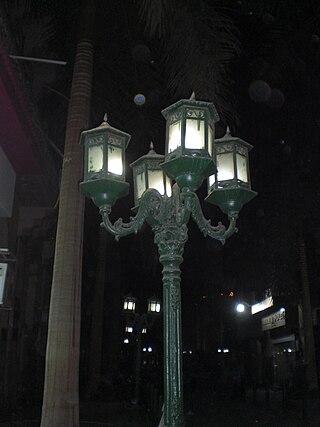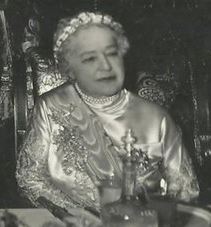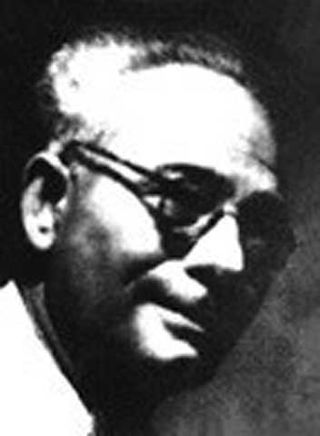
The Cairo Tower is a free-standing concrete tower in Cairo, Egypt. At 187 m (614 ft), it was the tallest structure in Egypt for 37 years until 1998, when it was surpassed by the Suez Canal overhead powerline crossing. It was the tallest structure in North Africa for 21 years until 1982, when it was surpassed by the Nador transmitter in Morocco. It was the tallest structure in Africa for one year until 1962, when it was surpassed by Sentech Tower in South Africa.

Abdelfattah Amr, better known as "F.D. Amr Bey" or simply "Amr Bey", was an Egyptian diplomat and squash player. He won the British Open men's title six consecutive times (1933–38), and is considered the first truly dominant squash player in the sport.

Heliopolis was an early 20th century suburb outside Cairo, Egypt, which has since merged with Cairo and is administratively divided into the districts of Masr El Gedida and El Nozha in the Eastern Area.

Roda Island is an island neighbourhood in the Nile in central Cairo, alternatively or partially known as Manial al-Roda, or al-Manial, in reference to the main village that existed on the island before it was urbanised, and is part of the Misr al-Qadima district.

Hadaek al-Qubbah is a district in the Northern Area of Cairo, Egypt.

Zamalek is a qism (ward) within the West District in the Western Area of Cairo, Egypt. It is an affluent district on a man-made island which geologically is part of the west bank of the Nile River, with the bahr al-a'ma cut during the second half of the 19th Century to separate it from the west bank proper. The northern third has been developed into a residential area, which was home to 14,946 people during the 2017 census. The southern two thirds are mostly sports grounds and public gardens, a stark green reserve in the middle of Cairo.

The Museum of ModernEgyptian Art, is Cairo, Egypt's main modern art museum holding collections of early 20th Century contemporary art pioneers, including Mahmoud Said, Ragheb Ayad, Gazbeya Sirry, and Abdel Hadi Al-Gazzar, among others. It was inaugurated in 1927 and is part of the National Cultural Centre in the former fair grounds of Zamalek.

The Qasr el Nil Bridge, is a historic swing bridge structure dating from 1931 which replaced the first bridge to span the Nile River in central Cairo, Egypt. It connects Tahrir Square in Downtown Cairo on the east bank of the river, to the southern end of Gezira/Zamalek Island. At the bridge's east and west approaches are four large bronze lion statues; they are late 19th-century works by Henri Alfred Jacquemart, French sculptor and animalier.

Gezira is an island in the Nile, in central Cairo, Egypt. The southern portion of the island contains the Gezira district, and the northern third contains the Zamalek district.
Charles Habib Ayrout was an architect practising in Cairo and is considered one of that city's 'pioneer' generation, as well as a Belle Epoque/Art Déco (1920–1940) architect for his landmark buildings and villas,. and was one of the most active builders in its Heliopolis district. He summarised his approach in 1932 as to “bring to Heliopolis the principles of modern architecture, but not of avantgarde architecture."

Qasr El Nil Street, is a street in downtown Cairo, Egypt, one of the biggest streets in Cairo, with many businesses, restaurants, and an active nightlife.

Melek Hassan Tourhan was the second wife of Sultan Hussein Kamel of Egypt. After her husband ascended the throne in 1914, she became known as Sultana Melek.

Gustave Lefebvre was a French Egyptologist. As inspector for Middle Egypt for the Egyptian Antiquities Service headed by Gaston Maspero, he managed the partage of Ludwig Borchardt's excavations at el-Amarna, Egypt, on 20 January 1913. Borchardt and Lefebvre had come to an agreement where the artifacts found the year before by Borchardt's team would be split between the German Oriental Company and the country of Egypt "à moitié exacte", or 50-50. The bust of Nefertiti, discovered in the sands of the studio of the sculptor Thutmose, and was a piece that Borchardt wanted for Germany. Recent evidence proves that Borchardt manipulated his way into keeping the bust. Borchardt first showed the Egyptian official a photograph of the bust "that didn't show Nefertiti in her best light". In the accompanying documents, the object was listed as a painted plaster bust of a princess. When Gustave Lefebvre came for inspection, the bust was tightly wrapped up in the bottom of a box. The document reveals that Borchardt claimed the bust was made of gypsum to mislead the inspector. Borchardt was one of the leading Egyptologists in the world, and knew that the bust was actually made out of limestone. The bust was one of the artifacts at the top of the exchange list but was never asked for by the Egyptians in 1913. The bust of Nefertiti was granted to Germany according to the provisions of Law No. 14 of 1912, and is today a primary exhibition of the Neues Museum in Berlin. Time magazine lists the bust of Nefertiti as one of the world's top 10 plundered artifacts.
Ali Labib Gabr was an Egyptian architect who practiced during the second quarter of the 20th century. He was the first Egyptian Dean of the School of Architecture at Cairo University (1946-1955), and is noted for being a leading 'pioneer architect' in designing both workers housing and luxury villas, in particular that of Arab diva Om Kalthoum in the Cairo neighbourhood of Zamalek.

Moïse Lévy de Benzion (1873–1943) was an Egyptian department store owner who built an important collection of art and antiquities. The collection was plundered by the Nazis in France during the Second World War and nearly 1000 items seized.

Ahmed Sabri, also spelled Ahmad Sabry was an Egyptian painter born in Cairo. He was one of the most prominent pioneers of modern portraiture art in Egypt.

The following outline is provided as an overview of and topical guide to Cairo:

Mario Rossi (1897-1961) was an Italian architect and notable contributor to 20th-century Islamic architecture.















